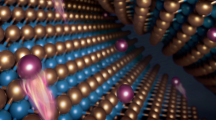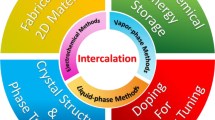Abstract
Speaking about the applications of intercalation compounds is quite challenging since there are currently only a few examples of them, at least from an industrial point of view.
Access this chapter
Tax calculation will be finalised at checkout
Purchases are for personal use only
Preview
Unable to display preview. Download preview PDF.
Similar content being viewed by others
Literature
Lithium batteries. Book edited by J. P. Gabano, Academic Press 1983.
Handbook of conducting polymers, vol 1 and 2; T. A. Skotheim Editor, Marcel Dekker 1986.
Ageing of rechargeable lithium batteries A. de Guibert and A. Hermelin International symposium on lithium batteries, Paris 15 April 1984 J. of Power Sources 1985.
Performances of rechargeable Li / MoS2 cells W. A. Adams, G. J. Donaldson and J. A. R. Stiles 14 th International Power Sources Symposium 1984
V2 O5 — P2 O5 glasses as cathode for lithium secondary battery Y. Sakurai and J. Yamaki J. Electrochem. Soc., 132, 512 (1985).
Kinetics of semiconducting polymer electrodes in lithium cells B. Scrosati, S. Panero, P. Prosperi, A. Corradini And M. Mastragostino J. of Power Sources, 19, (1987) 27–36.
Charge transfer complexes between sulphur an polyacetylene like materials A. Le Mehaute, A. Perichaud, P. Bernier, Tran Van Hoang et A. Guyot Synthetic Metals, 11, (1985) 373–375.
Organic conducting polymers derived from substituted thiophenes as electro — chromic materialf. Garnier, G. Tourillon, M. Gazard et J. C. Dubois J. Electröanal. Chem., 148 (1983) 299–303.
Author information
Authors and Affiliations
Editor information
Editors and Affiliations
Rights and permissions
Copyright information
© 1987 Springer Science+Business Media New York
About this chapter
Cite this chapter
Fauvarque, JF. (1987). Intercalation compounds: comparative possible electrochemical applications. In: Legrand, A.P., Flandrois, S. (eds) Chemical Physics of Intercalation. NATO ASI Series, vol 172. Springer, Boston, MA. https://doi.org/10.1007/978-1-4757-9649-0_15
Download citation
DOI: https://doi.org/10.1007/978-1-4757-9649-0_15
Publisher Name: Springer, Boston, MA
Print ISBN: 978-1-4757-9651-3
Online ISBN: 978-1-4757-9649-0
eBook Packages: Springer Book Archive




